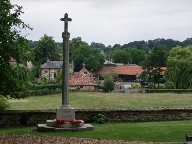| |
|
All
Saints, Shouldham
 |
|
West
Norfolk is not generally East Anglia's most
beautiful area, but there can be few more lovely
spots than this churchyard overlooking the
village in the valley below. The First World War
memorial stands like a sentinel, and in the field
beneath there are medieval earthworks which
stretch away towards the village street. There is
a sense of continuity, and on the heat of this
day in high summer there was a gentle haze, the
drone of an itinerant bee and the occasional
flick and swish of a tail from the lazy cattle on
the other side of the wall. The names
on the memorial seem far too many for such a
small, remote parish, and are a reminder of the
extent to which that conflict affected the poor
rural people of Norfolk, and left the county
changed forever. I sat on the base of the
memorial, my back to the church, thinking about
the hundreds of men of west Norfolk who had been
lost at Gallipoli, all so many on the same day,
even the same hour.
|
Parish
churches provide a continuity down the centuries, down
the long generations; but they are also touchstones to a
more recent and more haunting past. When I was a child
there were still many men alive who had fought in the
trenches of the Western Front. Men who had fought on the
Somme and at Passchendaele, in the Dardanelles and the
Middle East, were then in their late seventies, and were
set apart. People did not talk about the War when I was
child, and so few of these men were ever able to share
and heal their memories. As I grew older, so a general
interest in the War and the experience of it for ordinary
soldiers grew; but those men, boys really, who had fought
in it were dying out. A few weeks after I sat here on
this beautiful lonely hillside, Harry Patch and Henry
Allingham, the last two British survivors of the
conflict, were both dead.
I think
now of my great-grandfather and my great-great-uncle, who
were both killed in the Battle of the Somme. My
Great-Great-Uncle Harry was one of the very first to die
on the very first day of the Somme. He was a private
soldier in the 11th Suffolks, the renowned Cambridge
Battallion, who went over the top at 7.32am on that
beautiful summer morning along with the Grimsby Chums, at
at a place known as Sausage
Valley, just south of La Boisselle, to the east of the
town of Albert.
Malcolm Brown, in the Imperial War Museum Book of the
Somme, records that ...within two
minutes of zero hour, before they had cleared the front
trench, they had been raked by machine-gun fire. The
Lincolnshires lost 15 officers and 462 other ranks, the
Suffolk battalion 15 officers and 512 other ranks. An
artillery officer who walked the ground later found 'line
after line of dead men lying where they had fallen'.
On the war memorial in the tiny
village on the outskirts of Cambridge where he was born,
my great-great-uncle's is the first name. But there are
eleven other names on the memorial in that parish of
fewer than a hundred people, and three of them were also
killed in the same attack. How dreadful it must have been
when the news reached the village one morning in the
early days of July 1916. He was nineteen years old. My
mother's side of the family was forever shadowed by the
pain and grief of losing him, and every name on the
Shouldham war memorial must have been the catalyst of a
similar pain, a similar grief.
I would
have liked to have wandered into the numinous interior of
All Saints church to contemplate further; but this church
is kept locked, and there is no keyholder notice. I have
spoken to several other Norfolk church explorers, and
none of them has ever seen the inside of Shouldham
church. And so, it is a dying church, I suppose; for what
use is a church if it is only there for the Sunday club?
As for the exterior, it is grand, the combination of 14th
Century Catholic piety and 19th Century Anglican
triumphalism. The use of carstone in the tower makes it
seem even more substantial, and the chancel is all of its
1870s rebuilding. I suppose that there are things of
interest inside.
| I thought again of the
names of the boys on the war memorial overlooking
the village - it must be visible from many of the
houses. I thought of the comfort that the church
might have offered the families of the dead, if
only to heal their grief and give them a sense
that there is more to life than the merely
visible. The Church of England was reaching the
point of its highest influence at the time of the
First World War; but it would wane, and is waning
still today, the denomination becoming a shadow
of its former self, at least in terms of its
power and influence. However, it seems that it is
increasingly aware of its mission to
non-churchgoers, to the pilgrim and the stranger,
to the local community. Perhaps not in Shouldham,
though. As so often,
I thought of Larkin, and wondered who will be
the last, the very last, to seek this place for
what it was? Larkin was an agnostic, of
course, but I think there is a real optimism in
his final conclusion that someone will
forever be surprising a hunger in himself to be
more serious, and gravitating with it to this
ground, which, he once heard, was proper to grow
wise in, if only that so many dead lie round.
|
|
 |
|
|
|



